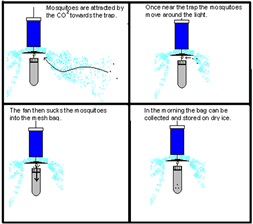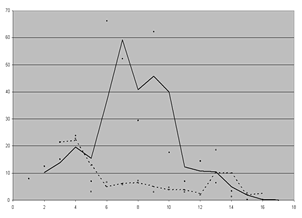DHHS → MeCDC → Disease Surveillance → Epidemiology → Vector-borne Diseases → Municipality Information on Mosquitoes.
Municipality Information on Mosquitoes
On this page:
What is mosquito surveillance?
Mosquito surveillance is trapping mosquitoes in a way that they can be systematically evaluated and/or tested for disease. The most common way it is done is with a small trap that uses dry ice to emit CO2, which is attractive to most female mosquitoes. The trap also has a little fan that blows into a mesh bag. When the female mosquitoes fly to the CO2 they are sucked into the mesh bag by the fan.

The mosquitoes then wait in the bag alive until they are collected the next morning. Then the mosquitoes are identified and sorted to one of the 46 different species of mosquito in Maine and kept on dry ice so that they can be tested. The pool, a group of mosquitoes of the same species, can then be sent to a lab where they grind them up and test them to see if one of those mosquitoes was carrying a virus.
From one trap we can monitor the mosquito species, how many are caught on a single night and test mosquitoes for the presence of West Nile virus or eastern equine encephalitis. Finally, we can determine whether control measures are necessary and what types would be best.

Aedes vexans capture by week for Portland traps in 2005 vs 2006. Traps are averaged which allows comparison, but note that traps were different. In addition 17 weeks were trapped in 2006 compared to 13 for 2005. ( = 2005 moving average [2] and = 2006 moving average [2].)
We are urging municipalities to consider establishing a long-term surveillance program so that mosquito risk can be evaluated throughout the mosquito season. West Nile virus and eastern equine encephalitis, both transmitted to humans from the bite of a mosquito, have been detected in Maine. It is likely that both of these disease are going to continue to be in Maine at fluctuating levels. Mosquito surveillance has been found to be a useful early warning tool for estimating the risk of human transmission. In addition, mosquito surveillance is an important part of an integrated pest management (IPM) plan for controlling mosquitoes.
It is up to towns to monitor the risk of disease transmission, but the Mane Center for Disease Control and Prevention will give advice and facilitate the town’s surveillance efforts. We also may be able to test some of the more sinister mosquitoes that are trapped for West Nile virus or eastern equine encephalitis.
What are some of the options for doing mosquito surveillance?
There are two major parts of mosquito surveillance. The first is to catch the mosquitoes using a trap. The second is to identify the mosquitoes. Trapping mosquitoes can be easily learned and is often only done once a week. Identifying mosquitoes is a much trickier task and requires training. There are around 46 different species of mosquitoes in Maine and they do not all act the same way. Some do not threaten humans at all. Others have different life cycles that tell us that clearing weeds might be enough to get rid of many of them or that clearing the drains would be a better way to reduce populations. It is important that this part is done correctly.
There are a couple of ways for a town to conduct mosquito surveillance. The first would be for a town or group of towns to hire someone to do surveillance or add the duty to a current employee such as a school grounds keeper. Then, either send the mosquitoes to someone who is qualified to identify the mosquitoes or invest in training the collector (identification is often more time consuming than collecting). Whoever identifies the mosquitoes will have to be approved by the Maine CDC before they can send in specimens for virus testing. If a town decides to go this rout, I will advise the town or employee on the equipment needed to purchase and how to properly set, collect, and store the mosquitoes so that they can be tested.
Another way to conduct mosquito surveillance is to hire an outside group. Agencies or companies may not all cover your area or may have different prices for your area for many reasons. Unfortunately, I can not evaluate them for you at this time, but I would be happy to talk about any advise they give you to help you decide if that company is going to satisfy your needs. The agency/company will have to be approved to send in mosquito pools for testing, but they can contact the Maine CDC for an approval visit at anytime in the year.
How does a town get their trapped mosquitoes tested for West Nile virus and/or eastern equine encephalitis?
In order for the Maine CDC to test mosquito pools for disease, we must first visit the group or place where the mosquitoes are being identified. The collection data plus the identified pools must be kept frozen at all times. The Maine CDC will then select pools to test based on the species of concern and abundance as shown from the collection data. Although we will not test every pool that is submitted, we will test those that will give us the best picture of risk from WNV or EEE.
If you are interested in getting the Maine CDC to approve you for submitting pools or are just curious about the process, please feel free to contact Disease Surveillance Epidemiology, at 1-800-821-5821 or e-mail: disease.reporting@maine.gov .
How can my town control mosquitoes?
In order to control mosquitoes and mosquito-borne disease in your town you must implement integrated pest management (IPM). IPM is a combination of tactics to properly control pests. Insects are extremely hard to control and adapt very quickly to our chemicals and treatments. However, if a properly designed program is conducted which utilizes a combination of control measures targeted toward the pest, the program is much more likely to be successful.
The first step is to conduct mosquito surveillance. Different mosquito species behave and grow differently and if you treat for one species you may not be reducing the other at all. Once the troublesome species have been identified and are being monitored, then a plan can be designed. Still, the plan should take into account more than simply spraying for mosquitoes. It may include reducing the habitat of the mosquitoes, treating the right places with the correct substance, and protecting sensitive areas.
IPM stands for integrated pest management. It is a simple way to say - using multiple ways to control a pest in a targeted manner.
The State’s definition is:
Chapter 413: INTEGRATED PEST MANAGEMENT (HEADING: PL 1991, c. 609, §2 (new))
§2401. Definitions
As used in this chapter, unless the context otherwise indicates, the following terms have the following meanings. [1991, c. 609, §2 (new).]
1. Integrated pest management. "Integrated pest management" means the selection, integration and implementation of pest damage prevention and control based on predicted socioeconomic and ecological consequences, including:
- Understanding the system in which the pest exists; [1991, c. 609, §2 (new).]
- Establishing dynamic economic or aesthetic injury thresholds and determining whether the organism or organism complex warrants control; [1991, c. 609, §2 (new).]
- Monitoring pests and natural enemies; [1991, c. 609, §2 (new).]
- When needed, selecting the appropriate system of cultural, mechanical, genetic, including resistant cultivars, biological or chemical prevention techniques or controls for desired suppression; and [1991, c. 609, §2 (new).]
- Systematically evaluating the pest management approaches utilized. [1991, c. 609, §2 (new).]
You can find Integrated Pest Management statute ![]()

